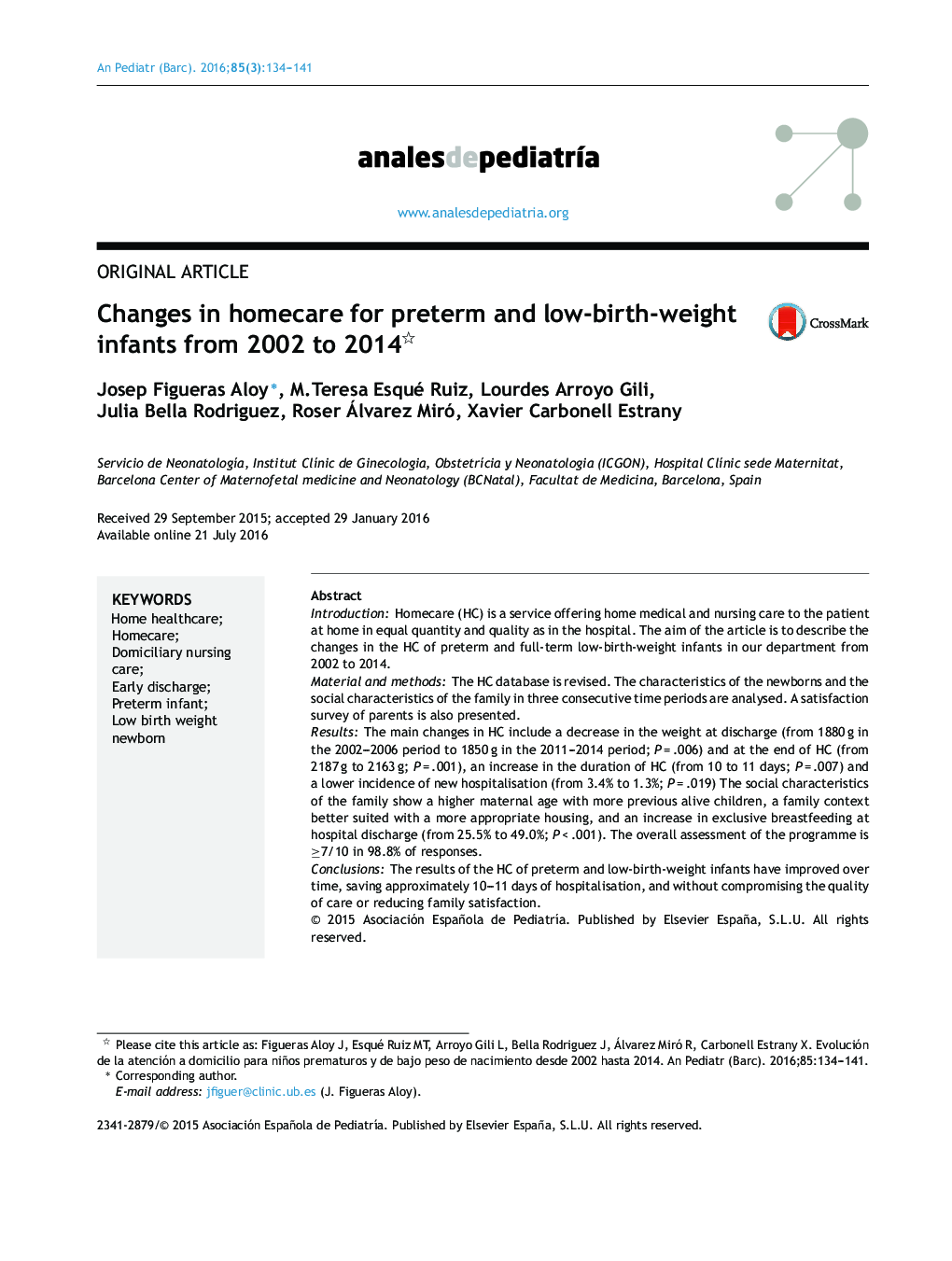| کد مقاله | کد نشریه | سال انتشار | مقاله انگلیسی | نسخه تمام متن |
|---|---|---|---|---|
| 4144944 | 1272576 | 2016 | 8 صفحه PDF | دانلود رایگان |
IntroductionHomecare (HC) is a service offering home medical and nursing care to the patient at home in equal quantity and quality as in the hospital. The aim of the article is to describe the changes in the HC of preterm and full-term low-birth-weight infants in our department from 2002 to 2014.Material and methodsThe HC database is revised. The characteristics of the newborns and the social characteristics of the family in three consecutive time periods are analysed. A satisfaction survey of parents is also presented.ResultsThe main changes in HC include a decrease in the weight at discharge (from 1880 g in the 2002–2006 period to 1850 g in the 2011–2014 period; P = .006) and at the end of HC (from 2187 g to 2163 g; P = .001), an increase in the duration of HC (from 10 to 11 days; P = .007) and a lower incidence of new hospitalisation (from 3.4% to 1.3%; P = .019) The social characteristics of the family show a higher maternal age with more previous alive children, a family context better suited with a more appropriate housing, and an increase in exclusive breastfeeding at hospital discharge (from 25.5% to 49.0%; P < .001). The overall assessment of the programme is ≥7/10 in 98.8% of responses.ConclusionsThe results of the HC of preterm and low-birth-weight infants have improved over time, saving approximately 10–11 days of hospitalisation, and without compromising the quality of care or reducing family satisfaction.
ResumenIntroducciónLa atención domiciliaria (AD) se caracteriza por ofrecer al paciente en su domicilio atención médica y enfermera en igual cantidad y calidad que en el hospital. El objetivo es describir los cambios en la evolución de la AD del neonato en nuestro servicio, desde 2002 hasta 2014.Material y métodosSe revisa la base de datos de AD analizando las características propias de la AD y las características sociales de la familia en 3 periodos consecutivos. También se presenta una encuesta de satisfacción de los padres.ResultadosEn la evolución de la AD en los 3 periodos cabe destacar una disminución del peso al alta hospitalaria (de 1.880 g en el periodo 2002-2006 a 1.850 g en el periodo 2011-2014; p = 0,006) y al alta definitiva (de 2.187 g a 2.163 g; p = 0,001), un aumento de la duración de la AD (de 10 a 11 días; p = 0,007) y una menor incidencia de rehospitalizaciones (del 3,4 al 1,3%; p = 0,019) Las características sociales de la familia muestran una mayor edad materna con más hijos vivos previos, un contexto familiar mejor adaptado en una vivienda más correcta y un aumento de la lactancia materna exclusiva al alta hospitalaria (del 25,5 al 49,0%; p < 0,001). La valoración global del programa es ≥ 7/10 en el 98,8% de respuestas.ConclusionesLos resultados de la AD del prematuro y recién nacido de bajo peso han ido mejorando a lo largo del tiempo, permitiendo ahorrar aproximadamente 10-11 días de ingreso hospitalario, sin menoscabar la calidad asistencial ni disminuir la satisfacción familiar.
Journal: Anales de Pediatría (English Edition) - Volume 85, Issue 3, September 2016, Pages 134–141
